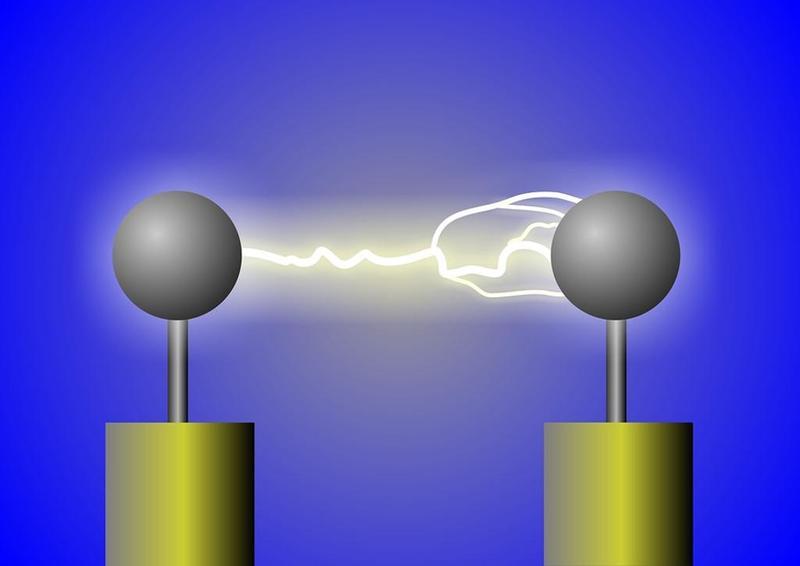First brain-to-brain ‘telepathy’ communication via the Internet
First brain-to-brain ‘telepathy’ communication via the Internet
The first brain-to-brain telepathy-like communication between two participants via the Internet has been performed by University of Washington researchers.*
The experiment used a question-and-answer game. The goal is for the “inquirer” to determine which object the “respondent” is looking at from a list of possible objects. The inquirer sends a question (e.g., “Does it fly?) to the respondent, who answers “yes” or “no” by mentally focusing on one of two flashing LED lights attached to the monitor. The respondent is wearing an electroencephalography (EEG) helmet.
By focusing on the “yes” light, the EEG device generates send a signal to the inquirer via the Internet to activate a magnetic coil positioned behind the inquirer’s head, which stimulates the visual cortex and causes the inquirer to see a flash of light (known as a “phosphene”). A “no” signal works the same way, but is not strong enough to activate the coil.
The experiment, detailed today in an open access paper in PLoS ONE, is the first to show that two brains can be directly linked to allow one person to guess what’s on another person’s mind. It is “the most complex brain-to-brain experiment, I think, that’s been done to date in humans,” said lead author Andrea Stocco, an assistant professor of psychology and researcher at UW’s Institute for Learning & Brain Sciences.
The experiment was carried out in dark rooms in two UW labs located almost a mile apart and involved five pairs of participants, who played 20 rounds of the question-and-answer game. Each game had eight objects and three questions. The sessions were a random mixture of 10 real games and 10 control games that were structured the same way.*
Participants were able to guess the correct object in 72 percent of the real games, compared with just 18 percent of the control rounds. Incorrect guesses in the real games could be caused by several factors, the most likely being uncertainty about whether a phosphene had appeared.
The study builds on the UW team’s initial experiment in 2013, which was the first to demonstrate a direct brain-to-brain connection between humans, using noninvasive technology to send a person’s brain signals over the Internet to control the hand motions of another person. Other scientists had previously connected the brains of rats and monkeys, and transmitted brain signals from a human to a rat, using electrodes inserted into animals’ brains.
The new experiment evolved out of research by co-author Rajesh Rao, a UW professor of computer science and engineering, on brain-computer interfaces that enable people to activate devices with their minds. In 2011, Rao began collaborating with Stocco and Prat to determine how to link two human brains together.
“Brain tutoring” next
In 2014, the researchers received a $1 million grant from the W.M. Keck Foundation that allowed them to broaden their experiments to decode more complex interactions and brain processes. They are now exploring the possibility of “brain tutoring,” transferring signals directly from healthy brains to ones that are developmentally impaired or impacted by external factors such as a stroke or accident, or simply to transfer knowledge from teacher to pupil.
The team is also working on transmitting brain states — for example, sending signals from an alert person to a sleepy one, or from a focused student to one who has attention deficit hyperactivity disorder, or ADHD.
“Imagine having someone with ADHD and a neurotypical student,” Prat said. “When the non-ADHD student is paying attention, the ADHD student’s brain gets put into a state of greater attention automatically.”
“Evolution has spent a colossal amount of time to find ways for us and other animals to take information out of our brains and communicate it to other animals in the forms of behavior, speech and so on,” Stocco said. “But it requires a translation. We can only communicate part of whatever our brain processes.
“What we are doing is kind of reversing the process a step at a time by opening up this box and taking signals from the brain and with minimal translation, putting them back in another person’s brain,” he said.
\* “Telepathy-like” is KurzweilAI’s wording, meaning that no action by the subject outside of the brain were required in the communication. As noted above, the first experiment (known to KurzweilAI) to demonstrate a direct brain-to-brain connection between humans via the Internet, the UW team’s initial experiment in 2013, used involuntary finger movements on a keyboard. Proponents of “telepathy” or “psychic” experiments using the Internet as a link, if any, might counter this.
The researchers took steps to ensure participants couldn’t use clues other than direct brain communication to complete the game. Inquirers wore earplugs so they couldn’t hear the different sounds produced by the varying stimulation intensities of the “yes” and “no” responses. Since noise travels through the skull bone, the researchers also changed the stimulation intensities slightly from game to game and randomly used three different intensities each for “yes” and “no” answers to further reduce the chance that sound could provide clues.
The researchers also repositioned the coil on the inquirer’s head at the start of each game, but for the control games, added a plastic spacer undetectable to the participant that weakened the magnetic field enough to prevent the generation of phosphenes. Inquirers were not told whether they had correctly identified the items, and only the researcher on the respondent end knew whether each game was real or a control round.
by Kurzweil
Be the first to post a message!
